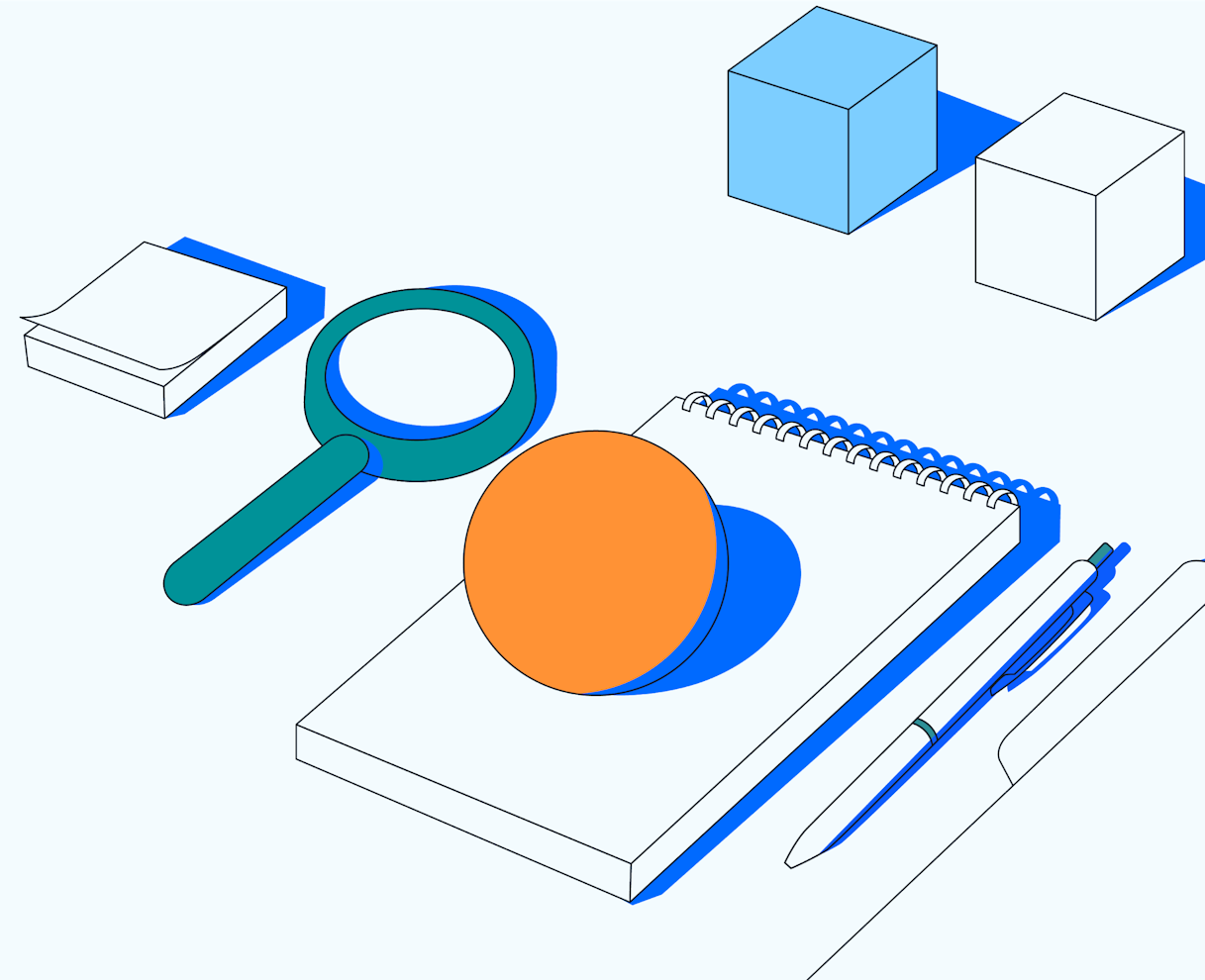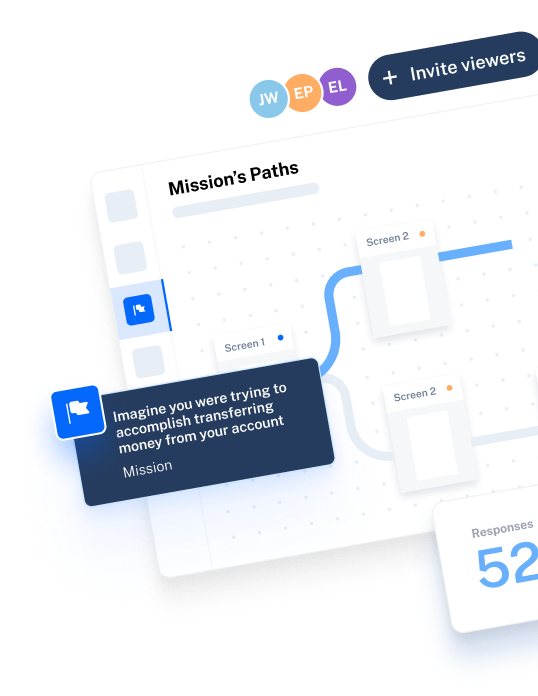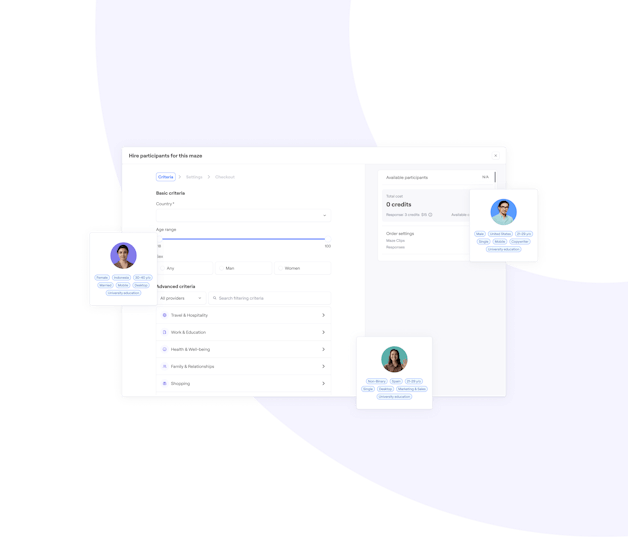TL;DR
A UX diary study is a long-term, qualitative research method that reveals real-world, self-reported user insights, helping teams understand changing user habits, emotional shifts, and how people use a digital product in their daily lives. Useful during product discovery, prototyping, and post-launch, diary studies in UX can be open or structured, digital or paper-based. While they offer deep, contextual data, they also present challenges, like participant fatigue, inconsistent self-reported logging, and time-consuming analysis. Diary studies are best used to explore long-term behavior in context or paired with other quantitative research methods for a complete picture.
Not all UX insights come from a single research session. Some take shape slowly across moments, days, or even weeks.
UX diary studies help you catch what interviews and other usability tests often miss. From early discovery to post-launch feedback, they give you a view into the messy, contextual, day-to-day reality of product use.
In this article, we break down when to run a diary study, how to set one up, what to watch out for, and how to get the most from your data.
What is a UX diary study?
A UX diary study—also known as diary research—is a longitudinal (running over a period of time) UX research method used for qualitative data collection. Participants keep a diary to record their thoughts, feelings, and behavior while using a product. The study can range from days to a month or longer. During this time, users log specific information about their activities regarding the product being studied.
Diary studies allow us to better understand the complexity of the user experience, which changes so drastically based on the use cases experienced by users, and the evolution of the product in their hands.
Matthieu Dixte
Product Researcher @ Maze
Share
Why use diary studies in UX research?
Diary studies give unique contextual insights about real-time user behavior and needs.
Unlike other research methods—such as usability tests or user interviews—diary studies provide qualitative data based on the reality of users interacting with products.
Product teams can use insights from diary studies to define UX features and requirements, creating a truly user-centered experience, without the guesswork.
The purpose of a diary study is to understand long-term behaviors such as habits, changes in behavior or perception (especially if your product is evolving), motivations, customer journeys, etc.
Matthieu Dixte
Product Researcher @ Maze
Share
Here are some of the benefits of diary studies in more detail:
Provides data with real-world context
One of the greatest benefits of diary studies is how they convey a product’s impact within a real-world context. Diary research requires study participants to interact with a product in their everyday life, and record data in-situ (or shortly after).
Where the majority of research methods ask participants questions outside a real-life scenario, diary studies do the opposite. As a result, you’ll receive far more reliable, honest, and contextualized data.
For example, say you’re making a travel maps app. During a usability test, users may find a few issues with the app. However, in the real world, users may discover that the app doesn’t work offline and makes navigation difficult. They may realize that some of the features they use most when actually navigating are ones they barely considered when sitting in a research room.
This contextual data is incredibly valuable and provides key feedback points to help product teams prioritize features and fixes.
Allows for a deep level of insight and micro-moments
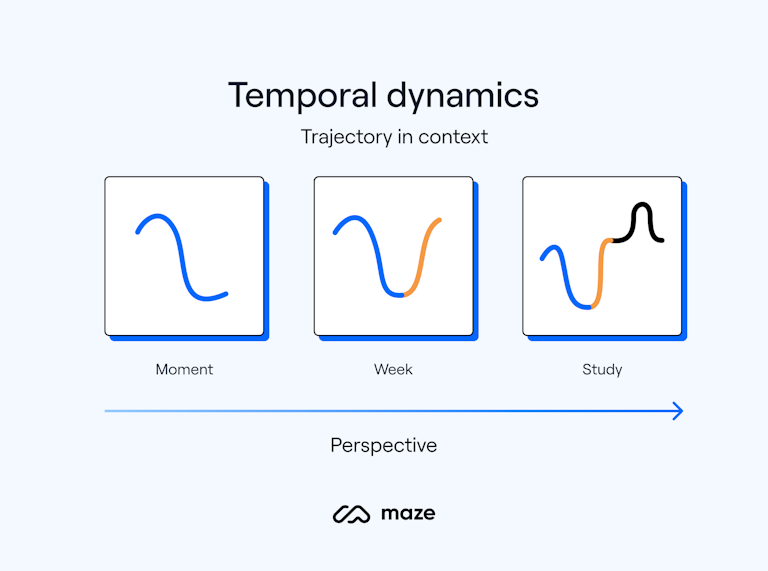
Diary research offers designers and Product teams a real-world understanding of how users interact with a product, so they can focus on the micro-moments of user experience.
Where some research methods reveal broad strokes of user insights, diary studies focus on the details that build a bigger picture of the user experience.
For example, if you’re researching what makes users purchase a new product, simply asking them “What made you purchase this product?” might provide a different answer than observing their thoughts and frustrations while they use the product over the course of a week or longer. A longitudinal study, like a diary study, will surface micro moments that accumulate during the user experience.
By giving participants the opportunity to record their own thoughts, feelings, and behaviors in the moments they happen—via a digital diary, mobile app, or diary study tool—you gain a deeper understanding of how your product impacts the user in real-world scenarios.
Some teams combine data from diary studies with experience sampling or quantitative data (like usage analytics) to complete the full UX picture.
Captures how behaviors change over time
Temporal dynamics refers to how perceptions and user behaviors change over time, and how those changes interact with and impact each other. For the sake of a product’s longevity, a diary study’s ability to reveal temporal dynamics is incredibly useful because it helps teams see how user needs evolve, where friction builds gradually, and which moments drive long-term adoption or abandonment.
Unlike many other UX research methods, diary research gives participants the opportunity to check in multiple times, record how their thoughts and feelings change over time, and reflect on their answers. It encourages self-discovery, providing you with a different perspective of insight to consider.
Diary research’s longitudinal approach means you can understand how different events, emotions, and moments impact user decisions and interactions with a product from day one, and right through to consistent usage.
Studying how user behavior changes over time can unlock unique insights such as:
User habits and usage scenarios:
- What does a typical day look like for users? When do they engage with the product?
- What behaviors are spontaneous vs. pre-planned?
- What behaviors are sporadic or habitual?
- When, why, and how does life interrupt usage of the product?
- What do users do before/after using the product?
- What are their workflows for completing their tasks?
Changes in behavior and perception:
- How learnable is a product?
- Do users share the product—or results of using the product—with others?
- Does using the product become part of their routine?
- What are users’ primary motivations for using the product? Does this change?
- What are their main tasks within the product? Does this change?
Attitudes and motivations:
- How do users feel before and after engaging with the product?
- How do they feel when they complete a task?
- Why do they make certain decisions?
- How do feelings and perceptions about the product change over time?
- What points of delight or pain points are there?
Gathering answers to these questions enables you to develop a richer understanding of your users and product, while also providing research questions, scenarios, and research goals for future tests. Diary studies can also help define what kind of follow-up survey questions or templates will be most effective for your next research project.
Diary research is one of the few research methodologies that provides respondents with autonomy, as well as a way to track their progress over time. This inherently means data is less likely to be biased in terms of the evolution of the results.
Matthieu Dixte
Product Researcher @ Maze
Share
Minimize bias and the impact of observation
Even in carefully planned, unbiased research studies, participants are often influenced by the presence of observation. Whether a study is moderated or not, participants are aware they’re being watched—consciously or not—which can lead to altered behavior, known as the observer effect. This often results in participants acting more carefully, skipping over pain points, or changing how they interact with a product—all of which can distort the data and reduce its accuracy.
For example, consider a field study: even though participants are in their natural habitat and you can observe their day-to-day life as they use your product, they may still behave differently from how they do when truly alone.
Diary studies allow researchers to simulate a more personal relationship between the user and the study than other research methods. If the purpose of research is to truly uncover how participants interact with a product, then diary research captures this at its most natural.
Another benefit is that—if prepared in advance—diary studies can be self-run, removing some of the resources needed to run other UX research studies. Of course, diary research still needs to be monitored intermittently, but depending on how much you plan to communicate with participants, they can be fairly self-sufficient.
To support ongoing studies, many teams use tools that simplify transcription, anonymize self-reported data, and enable data analysis. Just be mindful of sample size and potential dropout rates as your study evolves.
Approaches to conducting UX diary studies: Open vs. closed diary studies
There are two primary methods for conducting UX diary studies: open diary studies, which give participants the freedom to use the diary as they wish, and closed diary studies, which follow a tighter set of protocols.
Most researchers find that the ideal diary study method sits somewhere between open and closed, providing participants with a decent amount of guidance and reminders throughout the study, without overcrowding them. The method you choose will depend on your research objectives.
1. Freeform, open diary study
Similar to a personal journal, this type of diary research method gives participants a lot of freedom to decide how and when they record their diary entries. You’ll still need to give study participants some initial guidance or a lightweight template, but the diary itself is more free-form.
This method enables less-experienced respondents to take part, and people are likely to provide information you may not think to ask for, making it ideal for generative research. However, participants may not always include the details you need, and might include too little or too much information.
This can result in missing data, more complex data analysis, and the need for additional follow-up questions or even a follow-up interview.
2. Structured, closed diary study
A closed diary study uses pre-set research questions, prompts, and questionnaires, including closed-ended questions, to uncover user insights. Structured diaries may feature one page per study day, concluding questions, and explicit instructions on what to log and when to check in.
This method is ideal when you’re conducting evaluative research, testing specific functionality, or comparing entries across demographics and contexts, because the data is easier to analyze since it’s pre-formatted across all participants. This diary research method also ensures you collect the information that’s most relevant to your study.
The downside of this study type is that you may miss out on additional insights that don’t fit into the structure provided.
Diary study format: Digital vs. paper studies

Along with deciding between an open or closed diary study, you also need to determine the type of diary format you’ll use for your research.
Most diary study formats broadly fall within the categories of digital or paper. Unlike other research methods, the research tool you use for a diary study does not significantly impact the results, so the decision mostly comes down to the resources you have available or your team’s preferences.
The main difference between formats, besides cost, is that some digital research tools may analyze the results for you.
Paper diaries are a good, simple format for respondents, but there are big advantages to digital diary studies. You can ask follow-up questions, and have the ability to make sure respondents answer in the way you want them to. It’s also a big plus to be able to collect results little-by-little, and progress at the same pace as the analysis of results (even if sometimes it’s too early to draw conclusions.
Matthieu Dixte
Product Researcher @ Maze
Share
1. Digital/online diary study
Digital or online diary studies use tools like mobile apps, online forms, or messaging platforms (e.g., Maze, Google Docs, WhatsApp) to collect participant entries. These formats work best when your audience is tech-savvy and comfortable logging thoughts on their phone or laptop. They're ideal for capturing multimedia entries—like photos, videos, or screen recordings—and for running studies remotely across locations and time zones. Digital tools also make it easier to automate reminders, standardize input, and simplify data analysis.
- Digital tools, e.g., Maze
- Online platforms, e.g., Google Docs
- Mobile apps, e.g., Indeemo
- Digital communication platforms, e.g., WhatsApp
2. Paper/offline diary study
Paper or offline diary studies involve participants using a physical notebook, printed question sheet, or even an audio/video recorder to log their experiences. This format works well when you're researching offline products, running studies in low-connectivity environments, or working with participants who are less comfortable with or have limited access to digital tools.
It’s especially useful for in-the-field studies—for example, like testing outdoor gear—where carrying a notebook is simpler than using a phone. While these studies can be harder to collect and analyze, they often feel more natural and accessible for specific audiences.
- A physical diary (provided by the researcher or participant)
- Question sheet
- Video/audio log
When should you conduct diary research?
There are many circumstances when you may want to use diary studies, depending on your research objectives and the resources you have available. Depending on your focus, the period of time you’ll want to conduct your study may also vary.
Diary study objectives
The focus of a UX diary study can range from extremely specific (e.g., understanding all interactions within a specific section of a web page) to very broad (e.g., gathering general information about when people use a smartphone).
The Nielsen Norman Group suggests there are broadly four categories of diary study topics:
- Studying interactions with a product or website: Use a diary study to understand how people engage with a digital product across multiple touchpoints. For example, you might ask participants to log every time they visit a retail website, what they were looking for, how they navigated, and whether they completed a purchase or dropped off. This helps you uncover pain points in real-world usage that don’t show up in isolated usability tests.
- Observing patterns in user behavior: Diary research is great for capturing broader behavioral trends, like how and when people use their smartphones throughout the day. Participants might note when they check social media, respond to notifications, or switch between apps, helping you understand habits, dependencies, or moments of frustration in their digital routine.
- Understanding how people complete general activities: If you're exploring a broader use case like how users share articles or shop for gifts online, diary studies help you document the range of tools, platforms, and decisions people encounter. For example, a participant might detail how they go from discovering a product on Instagram to comparing prices on Amazon, to finally making a purchase via a brand’s website.
- Unpacking a specific decision or task over time: You can also zoom in on one defined activity, like researching and buying a new car. In this case, a diary study could track how users gather information, which resources they consult, what moments shape their trust in a brand or dealership, and how they feel at each stage of the decision-making process.
The best time to conduct a diary study
While diary studies can be conducted at any stage in the design process, they’re especially valuable at four key moments: during discovery, while testing early prototypes, at the end of development, and after launch.
- In the discovery phase, diary research can reveal how users currently solve the problem in question, giving you valuable context to plan your own solution. Discovery-phase diary research can also be conducted on existing products or against competitors, to set benchmarks or better understand how users interact with similar products and functionality.
- Testing early-stage prototypes can be done with diary research to gather qualitative information on the current success of your design and identify any pain points to address in future iterations.
- At the end of development, a diary study can delve into user experience in the closest simulation to real life. This is a chance to see whether users are interacting with your product as expected and uncover any missed opportunities for improvement.
- After launch, diary research is helpful as a type of follow-up interview to assess the success of a product and analyze performance in the real world. Is it meeting expectations? What changes should be implemented in updates?
Diary research doesn’t necessarily take more time than other quantitative research methods. While there’s passive time of the study to take into account, it’s the analysis that is time-consuming. You’re analyzing evolutions of behavior and in-depth patterns, each focused on a different respondent’s perspective. The insight is well worth the time, but it helps to do this analysis in bits and pieces as you progress through the study.
Matthieu Dixte
Product Researcher @ Maze
Share
Things to consider before conducting your diary study
Like other research methods, planning a diary study involves a lot of preparation. But the added element of diary research being fairly hands-off and taking place over a significant period of time means it’s even more important to ensure you’ve not missed anything.
To help, here are some things to consider before you begin your study:
What type of diary are you using?
Determine what type of study you want to conduct and the kind of diary study tool your participants will be using.
- Open or closed: As we mentioned, open diaries are ideal for generative research—like exploring how people form new habits around a wellness app—because they allow participants to share unexpected thoughts or experiences in their own words. Closed diaries work better for evaluative research, such as testing how users complete a checkout flow, where you need structured entries and direct answers to specific questions. Choose your approach based on how much structure your research needs and your UX research goals.
- Online or offline: Decide on the type of diary you want participants to use. Are your users tech-savvy and comfortable with electronic diaries or mobile apps? What activities are they logging? If you’re researching the durability of camping equipment, an offline diary that users can travel with may work best. However, if you’re studying cosmetic preferences, then maybe a video log where participants can record their usage would make sense.
What equipment do you need?
If you’re asking participants to use a certain product, have they received a physical item, product, or prototype? Do they need instructions for it? If you’re testing a website or app, do participants have access to the platform and clear instructions for logging in?
What kind of logging are you doing?
Before you can begin your study, think about how you’ll ensure diary entries are logged. There are several approaches to logging:
- In-situ logging (also called event-contingent protocol): Participants log when a relevant event occurs
When to use: Since this method asks participants to log information as it happens, it’s best for research where you don’t expect high volumes of log entries, as this could disrupt the participants’ usual activities and would be difficult to analyze later. For example, if you’re researching fashion retail websites, one of the events you’d ask participants to log may be each time they think about or browse clothing websites.
- Interval-contingent protocol: Participants are given predetermined intervals to report into, e.g., every three hours
When to use: This technique is effective if the research you’re conducting isn’t situation-dependent, if you want a broader picture of daily life, or if you’re unsure when the event may occur. For example, if you're researching the use of infant toys, an interval-contingent protocol may be useful, as it’s hard to predict the play patterns of young children.
- Signal-contingent protocol: Participants receive notifications of when to log. These can be sent manually or set up to automatically notify participants at regular or pre-planned intervals.
When to use: This method ensures you’ll receive an adequate amount of self-reported data (typically one per day, or more if you’re doing in-situ logging), and reduces the possibility of participants forgetting to log entries, however it requires a notification tool and research participants with some flexibility (unless you tailor notifications to their schedule).
- Snippet technique: Participants report events in the moment, using an easily accessible format (e.g., a couple of words on a post-it or phone note), then set aside a later time to expand on the snippet. This technique is less intrusive than others, while still ensuring immediate responses are captured.
When to use: Snippets are particularly effective if your participants have busy schedules, or the events you’re researching are likely to occur randomly or in different locations.
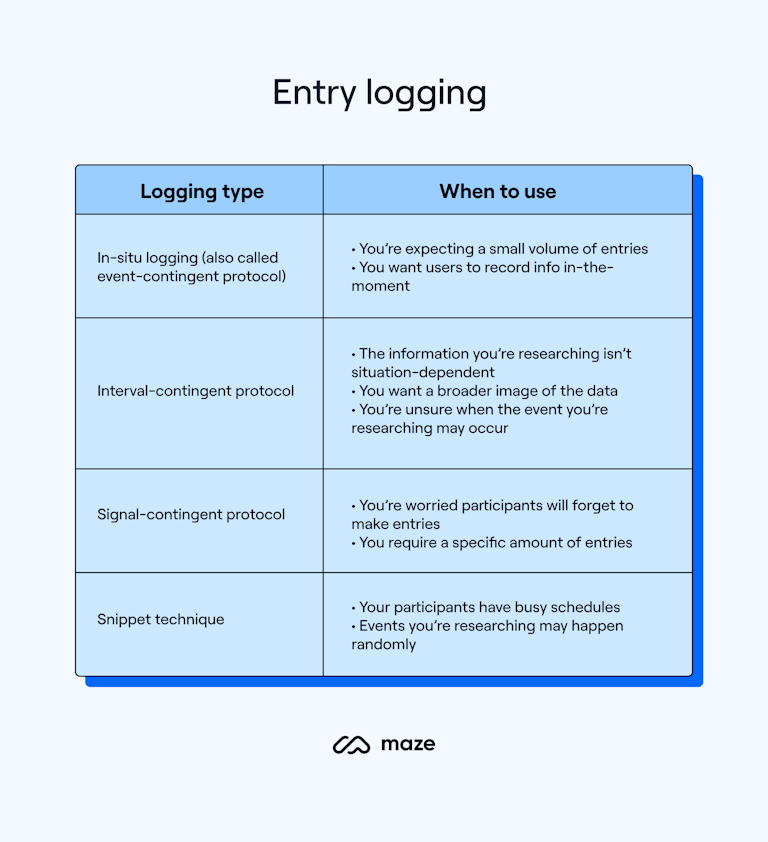
Preparing participants for a diary study
Recruiting and selecting participants for any UX research is a daunting task, but this step is particularly challenging for diary research—not only do you need participants who can answer your questions, but you need users who can understand and adhere to the demands of a long-term study.
Why your research participants matter
Since participants are logging entries over time, you’re not just looking for demographic alignment—you need individuals who can consistently engage, reflect on their experiences, and communicate them clearly.
If your participants don’t represent your real users, the insights you get can give you the wrong idea about how people actually use your product. And if they’re not suited to the diary format—maybe they don’t have time or aren’t comfortable with logging entries—you could end up with incomplete data or dropouts halfway through.
Take time to define who you're recruiting and why. The better the fit, the more useful your results will be.
When recruiting participants, don't hesitate to mention the reasons for this choice of method; this is also an opportunity to explain what they gain from being involved with this method.
Matthieu Dixte
Product Researcher @ Maze
Share
How to select diary study participants
Selecting participants for a diary study doesn’t have to be complicated. Here’s our formula for the perfect participants.
Participant profile + screening criteria x recruitment tool = great candidates
First, you want to build your participant profile (what your dream participant looks like) and consider any screening criteria (boxes they must tick). This will be heavily influenced by your target audience and research objectives—for instance, if you’re researching products for newborns, you want to ensure participants are new parents. Categories to consider include:
- Basic demographics (age, gender, marital status, nationality)
- Lifestyle (employment, hobbies, finances)
- Habits (schedule, interaction with products, type of customer)
Once you’ve narrowed down your ideal participant, use a recruitment tool with a built in screening survey for the most efficiency when gathering participants, and filter down to the best candidates. Bear in mind that having fewer testers with more accurate profiles is better than having a lot of testers with profiles that don’t always match your criteria.
In terms of numbers, your study may require as few as three, or as many as 30 participants—this number will shift depending on the scope and budget of your research. For a typical diary study, we suggest aiming to recruit 10–15 participants, with a couple of back-ups.
One tactic for recruiting participants is to incentivize them, to ensure follow-through with the entire study. You can also consider working with existing customers; this is particularly valuable if you're researching changes or new features for an existing product.
Take a look at our article on recruiting research participants for more advice.
5 Steps to conduct a diary study
While diary studies can run semi-independently, they only succeed with reliable data and minimal hiccups if you plan and prepare thoroughly from the start. In this section, we discuss five steps for planning and conducting your diary research.
I always follow ‘KISS’: keep it simple and smart. Your study needs to be quick and easy for users to complete, with clear and detailed instructions, to ensure they complete it regularly and accurately.
Matthieu Dixte
Product Researcher @ Maze
Share
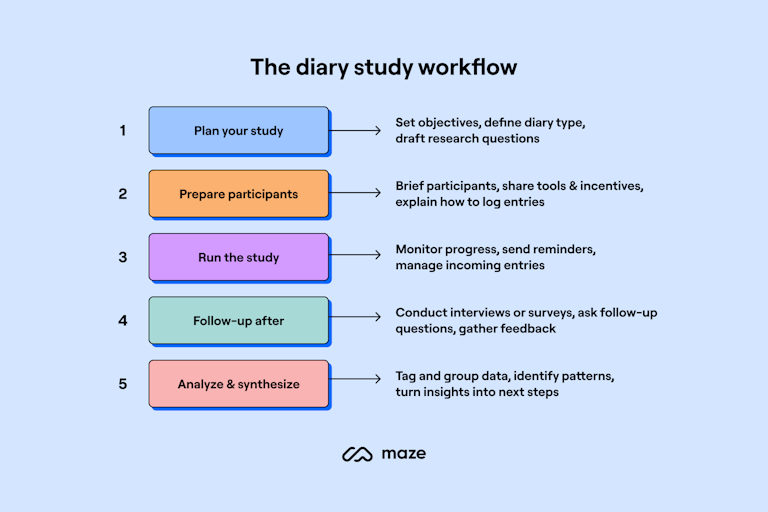
1. Plan your study
First up, it’s time to get organized and sketch out the parameters for your research.
Determine your objectives
Start by reviewing your main objectives. Are you researching an existing product or a new one? Do you want to understand specific interactions or broad behavioral information?
You can research multiple topics at once, but that will lead to more data to analyze, so ensure you link back any study objectives to broader research goals to avoid being inundated with unnecessary information.
Select your diary type
By this stage, you should already have considered what type of diary (online, offline, etc.) you’re using. But before you can prep your research or participants, you also need to determine the style of diary and entries. Choose from a freeform or structured diary, or even a combination, depending on your objectives.
Write your research questions
Now it’s time to define the core questions your study is trying to answer and decide how to present them to participants. In structured diaries, you’ll include specific questions for participants to answer with each log entry. In open or hybrid studies, you might share guiding questions in a briefing document at the start. You can also save some questions for follow-up surveys or interviews to clarify or expand on participant responses.
Some potential questions to consider are:
- Describe your day
- What were you doing before [event]?
- What was the hardest thing about achieving [task]?
- How did you feel before using [product]?
- What could have made [task] easier?
- How did you find using [product] today compared to last week?
Get 350+ examples of research questions in our research question bank 💡
Set your start and end dates
Some studies may only need a few days, while others can continue for weeks, or even months. The study length depends on your research goals, product, and topic—will the data you gather in a short period of time likely be the same as that collected over several weeks or months? If not, it may be worth continuing the study for longer to ensure you capture any temporal dynamics and a consistent, median dataset.
Work with participants to plan the best time for the study to take place—for example, if you need their full attention, is there a period when they have more free time? Or if you want to see how they interact with your product in everyday life, when is their routine most stable?
2. Prepare participants
Next, it’s time to onboard participants and prepare them for the study. Bear in mind that for maximum efficiency and quality of results, you won’t want to communicate with participants once the study is underway (unless you’re providing manual notifications to remind them to log their entries).
Make sure participants are fully briefed and understand the assignment:
- Create a ‘cheat sheet’ to guide participants (include key info about the study, how-tos, emergency contacts, etc.)
- Provide any props needed
- Plan any rewards or incentives
- Walk through the entry logging method
- Share any pre-study surveys
Education is key: take the time to explain the format to your respondents. Try to be transparent about the pace and format of answers; this will improve engagement and response rates over time from users.
Matthieu Dixte
Product Researcher @ Maze
Share
3. Progress with the research
Now it’s time to start researching!
Once participants begin logging their entries, this becomes the most hands-off phase for you as the researcher. While they’re busy with their part of the study, it’s a great time to prep your follow-up plan, organize your tagging system, or run other research in parallel.
While your study is running, you may want to communicate more or less with participants, depending on your diary and logging type. Keep any reminders or notifications consistent, and remember to be human. Recognize the input of engaged participants, and check in on those who appear to be struggling. Participants are opening up a vulnerable part of themselves with the study, so respect their boundaries and provide guidance where needed.
If you’ve arranged for entries to be sent to you as they’re logged, then you may find yourself overwhelmed by the amount of data coming in. Organization is everything, so take notes and process user input as you go—it will save a lot of time in the long run. For video or audio logs, either use a diary study tool that transcribes, or send entries for transcription.
Note: If you're already using Maze for your UX research, here's how Maze can help with diary studies, too.
💡 Diary studies can be combined with other UX research methods as a way to gather more data or expand the reach of your research while keeping to a budget. For example, combining diary research with a second, quantitative data research method can provide more well-rounded results.
4. Post-study follow-up
When the UX diary study comes to an end, consider meeting with each participant to discuss their entries in detail. If this isn’t possible, an async interview or follow-up survey works well, too.
This is also a good moment to gather feedback on the study itself. Asking participants what worked (and what didn’t) will help you refine your approach for next time.
Here are some example questions to ask during post-study follow-up:
- Were there moments you meant to log but didn’t? Why?
- What would have made it easier for you to participate?
- Was anything confusing or difficult about the study format?
- Did the process change how you thought about the product or task?
- Is there anything else you’d like to share that didn’t fit into the diary?
- Can you walk me through a specific entry you found important or memorable?
5. Process the data and analyze
If you’ve been using a digital diary research tool like Maze, your data may already be transcribed and organized, ready for tagging and analysis. If not, you can still upload video or audio files manually into Maze Interview Studies. Once uploaded, Maze uses Rev AI to generate transcripts in over 30 languages, helping you identify key themes and insights without starting from scratch.
Once your diaries are transcribed, it’s time to analyze and sort the data to identify patterns, synthesize research hypotheses, and track trends.
To make the task a little easier, we recommend breaking it into two stages:
- Identify your top participants: Who stands out, with either a particularly robust set of data, or significant patterns? It’s much easier to find evidence for an existing pattern, so use these individuals for leading takeaways and other entries to support your theory.
- Tag your data correctly: While tagging data isn’t always necessary, it’s valuable for diary research as it helps you organize unstructured, qualitative entries into themes. Go through responses and assign descriptive tags (e.g., activity types, like ‘housework’, ‘fitness’, ‘relaxation’). Next, work with your team to run thematic analysis (e.g., ‘fun’, ‘interesting’, ‘boring’). Finally, consider which tags commonly overlap to start identifying patterns.
With the right analysis, your raw user data can turn into valuable insights. These insights help you understand how people use your product in real-life settings—what’s working, where they struggle, and how their needs evolve—so you can make smarter, user-informed design decisions.
Challenges and limitations of diary studies
Like any UX research method, diary studies aren’t perfect, and it’s important to know where things can go wrong before you start.
Here’s a quick summary of the most common challenges before we get into the details:
Challenge | Description |
|---|---|
Participant fatigue | Logging over time leads to shorter entries, skipped logs, or participant drop-out |
Engagement drop-off | Motivation decreases mid-study, especially without reminders or incentives |
Self-reporting bias | Participants may misremember, over-filter, or shape responses unintentionally |
Missed behaviors | Researchers only see what participants choose to log—unexpected insights may be lost |
Time-consuming analysis | Reviewing, tagging, and synthesizing qualitative entries takes significant time |
High setup effort | Designing templates, onboarding, and troubleshooting require up-front investment |
Tool or tech friction | Participants may face issues using the digital diary or misunderstand the process |
Not suited for short studies | For short timeframes or one-off tasks, diary methods are often too intensive |
Limited fit for certain methods | Doesn't work well for observing functionality or real-time physical interaction |
Participant fatigue and engagement drop-off
One of the most common challenges in diary studies is participant fatigue. Logging experiences over time—especially in longitudinal studies—requires sustained effort and attention to detail. What starts out as a novel task can quickly become repetitive, especially if participants don’t understand the purpose or don’t see the value in their contributions.
Fatigue can also contribute to higher dropout rates, which impacts your sample size and forces you to either over-recruit up front or run additional follow-up rounds. While using digital diary tools or sending friendly check-ins can help maintain momentum, they’re not a cure-all. The best ways to reduce fatigue are to keep the logging format simple, be transparent about time commitment, and offer incentives that reflect the effort involved.
Bias from self-reported data
As mentioned earlier, diary research relies on self-reported entries, which introduces bias. Participants may unintentionally misreport what happened, delay their logging, or shape responses based on what they think you want to hear. This is especially risky in experience sampling methods, where the goal is to capture raw, in-the-moment impressions. Even with structured questionnaires or follow-ups, the data depends heavily on participant accuracy and honesty.
Gaps in what participants log
Even the most honest participants don’t log everything. Some moments feel too small to mention, others get forgotten, and some might not seem relevant from their point of view. But these “missing” details can include habits, reactions, or problems that matter to your research. You could miss out on small frustrations, unexpected behaviors, or everyday workarounds that don’t get logged, but still shape the user experience.
To reduce these gaps, add short follow-up questions or check-ins to remind participants of what to include. If you’re running a structured study, make sure your prompts are clear and specific so participants know what kind of details you’re looking for.
Time-consuming data analysis
Qualitative research produces a lot of unstructured information, and diary studies are no exception. Reviewing entries, transcribing (if needed), tagging, and synthesizing data into themes creates a lot of work for researchers. While diary study tools with built-in transcription or tagging features help, they still require manual effort to group responses, analyze sentiment, and align logs to your research goals.
High setup and logistical effort
Before the study even begins, you need to define your study design, create templates, develop logging protocols, test your tools, recruit participants, and ensure everyone understands how to participate. This preparation is critical, but time-consuming. You'll also need to troubleshoot any issues with the research tool, especially if participants aren’t tech-savvy or are using different devices.
Technical barriers and tool friction
If your study uses digital tools, apps, survey platforms, or chat-based prompts, be mindful of the experience you're asking users to adopt. Participants might struggle with the interface, use outdated devices, or misunderstand the process entirely. A confusing or clunky tool increases drop-off and degrades the quality of responses. Test your tools ahead of time, offer walkthroughs, and keep things lightweight.
Not a fit for every research method or for short studies
Diary studies work best when you're tracking evolving behavior, emotions, or usage patterns over time. But they aren’t the right fit for short-term or one-off interactions. If you’re testing specific functionality or need to observe physical interaction, a field study or in-person user interview may be more efficient. Similarly, if your research window is just a day or two, the overhead of a diary format may not be worth it.
Alternatives to diary research
Of course, diary studies won’t always be the perfect fit for your research project. It has its downfalls—self-reported data may be unreliable, and keeping a diary requires significant dedication from participants. So, if you’re looking for immediate results, have a very limited budget, or are focused on a simple usability question, then diary research probably isn’t for you.
Some alternatives to diary research include:
- Surveys and questionnaires
- Interviews
- User analytics
- Focus groups
Diary studies can also be combined with other methods as a way to gather more data or expand the reach of your research while keeping to a budget. What’s more, opting for a second, quantitative data research method can provide more well-rounded results in combination with diary research.
Get in-depth insights with diary studies
Diary studies in UX research are key for getting insights into how your product performs in the real world. It gives research participants the freedom to share their thoughts and feelings without the pressure of a standard research environment.
Use diary studies to uncover user motivations, behavior, and needs that inform your product design and development. All you need to do is plan your study, recruit users, and provide a structured or unstructured diary.
The hardest part of diary studies is finding the right participants—but Maze can help. Maze Panel gives you access to pre-screened, ready-to-go research participants that you can filter and recruit as per your needs.
Start getting better insights today to build better products for your users.
Frequently asked questions about diary research
How do you write a diary study?
How do you write a diary study?
To write a diary study, you first need to determine the type of diary you plan to use. For an open/freeform diary, participants have the freedom to write what they want when they want. For a closed/structured diary, you may want to write a set of clear instructions, provide questions for each day of the study, and write follow-up questions.
How long should a diary study last?
How long should a diary study last?
The length of a diary study depends on your objectives, available resources, and research area. Diary studies can last anywhere from a few days to a few months.
When should you do a diary study?
When should you do a diary study?
You should consider running a diary study when you want to:
- Gather data with real-world context
- Understand micro-moments that build a big picture
- Capture temporal dynamics and how behaviors change over time
- Give participants time to think deeply about answers
- Minimize the impact of observation



